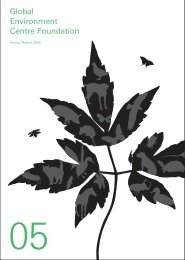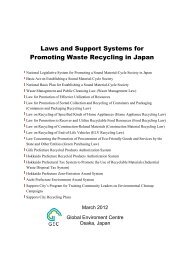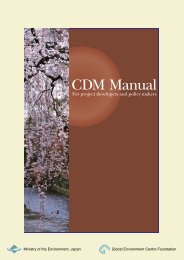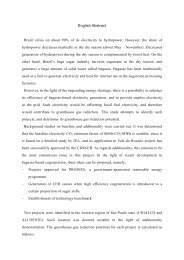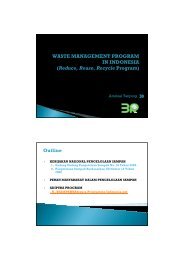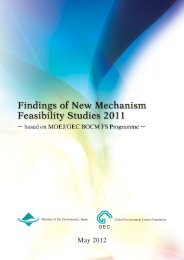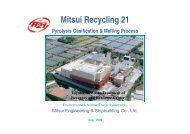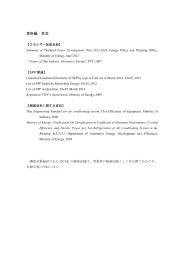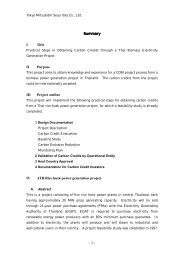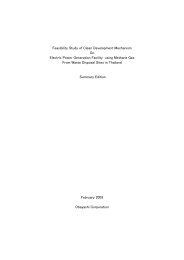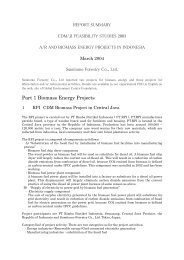PDF File - GEC
PDF File - GEC
PDF File - GEC
You also want an ePaper? Increase the reach of your titles
YUMPU automatically turns print PDFs into web optimized ePapers that Google loves.
4.2. JI institutions and procedures<br />
4.2.1. JI institutions 11<br />
The institutions for the JI consist of the following:<br />
(1) COP/MOP<br />
The Conference of the Parties serving as the meeting of the Parties to the Kyoto Protocol (COP/MOP)<br />
shall provide guidance regarding the implementation of Article 6 and exercise authority over the JI<br />
Supervisory Committee [JI guidelines, para. 2].<br />
(2) Designated Focal Point (DFP)<br />
A Party involved in a JI project shall inform the secretariat of its designated focal point for approving<br />
JI projects. In addition, a Party involved in a JI project shall inform the secretariat of its national<br />
guidelines and procedures for approving JI projects, including the consideration of stakeholders’<br />
comments, as well as monitoring and verification. [JI guidelines, para. 20]<br />
(3) JI Supervisory Committee (JISC)<br />
The JISC shall supervise the verification of ERUs generated by JI project activities and shall comprise<br />
of 10 members (also 10 alternate members) from Parties to the Kyoto Protocol. 3 members each from<br />
Annex I Parties that are undergoing the process of transition to a market economy, Annex I Parties<br />
that are not undergoing the process of transition to a market economy, Non-Annex I Parties and 1<br />
member from the small island developing States [JI guidelines, para. 4].<br />
(4) Accredited Independent Entity (AIE)<br />
An accredited independent entity (AIE) is an entity accredited by the JISC in accordance with<br />
standards and procedures contained in Appendix A of the JI guidelines. An AIE is responsible for the<br />
determination of whether a project and the ensuing GHG emission reductions or enhancements of<br />
removals meet the relevant requirements of Article 6 of the Kyoto Protocol and the JI guidelines. In<br />
short, the AIE under the JI scheme has similar functions with the DOE under the CDM, but is more<br />
responsible for its determination. Under the CDM, the DOE is responsible to validate the PDD, and<br />
to check the applicability of the approved methodology to the proposed project. Under the JI, the<br />
AIE has to assess the concepts of baseline setting and monitoring in accordance with the criteria for<br />
baseline setting and monitoring set out in Appendix B of JI guidelines because there are no approved<br />
methodologies (AMs). In the case the project participants select to use the CDM AM to the proposed<br />
JI project, the AIE shall assess whether all explanations, descriptions and analyses refer to the selected<br />
CDM methodology.<br />
The JISC discussed the proposal to develop a “validation and verification manual” for JI and decided<br />
to consider it further at JISC13 [JISC12, para. 33]. The procedure for accrediting independent entities<br />
by the JISC (Version 03) [JISC 09, Annex 1] was adopted at JISC09. The scheme for the JI accreditation<br />
procedure is shown in Figure 4-2.<br />
The assessment of an applicant IE under the JI accreditation process consists of three main elements:<br />
desk review, on-site assessment, and witnessing [JISC09, Annex 1, para 4]. Those elements are the<br />
same as CDM accreditation process. The scope of accreditation of an AIE refers to both its functions<br />
66<br />
11 The JISC, AIE, JI-AP and JI-ATs are only relevant for JI Track 2.



